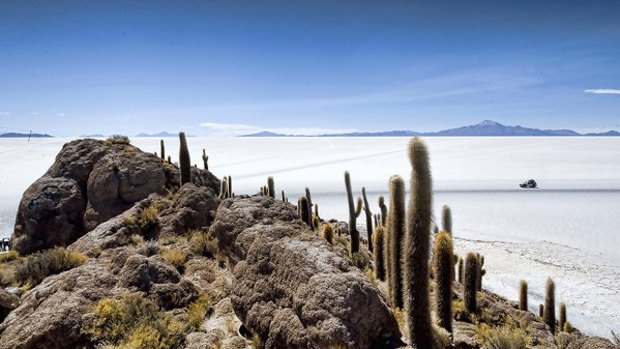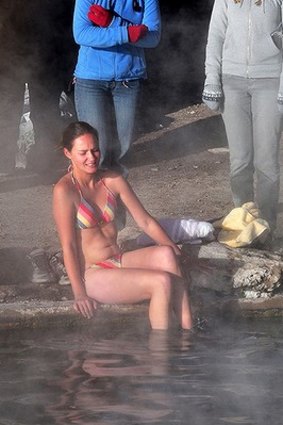On a surreal road trip across the frigid altiplano, Catherine Best takes a crash course in mechanics.
The dead bird is a bad omen. Slumped in the sand, it looks like a disgorged pillow of white feathers. For our eagle-eyed guide, though, it's a trophy find.
For 10 minutes we sit in the four-wheel-drive as he prods at the wretched creature. It seems our guide fancies himself as a taxidermist and is seriously considering throwing the carcass on board.

Look again ... a vehicle traverses the world's largest salt flat.Credit: AFP
I'm unnerved. Will the bird be worth stuffing by the time we get back? More importantly, can we survive the four-day trip with its ripening remains? Reluctantly, he decides to let the bird be.
Twenty-four hours later, the bird is pecking at my mind as we barrel through the frigid altiplano of Bolivia, a surreal lunar landscape high in the South American Andes. Cold, desolate and windswept, the desert flats that occupy the country's south-west corner are among some of the continent's most inhospitable landscapes.
This is volcano country, a prehistoric panorama of cinnamon sands, hallucinogenic lagoons and bubbling sulphur geysers. Its highest navigable point is about 5000 metres. My guidebook warns that the wind here has teeth but I find this is an understatement. It must be one of the worst places on Earth for your vehicle to break down.

A tourist enters the water at a hot spring near the small village of Agua Brava on the salt flats.Credit: AFP
There are six of us in the group: my partner and I; a mid-30s English couple; our driver, Hernan, who speaks no English and has a ball of chewed coca leaf permanently disfiguring his cheek; and our guide, Archie, who doubles as the cook and looks like a Louie the Fly caricature with his bulbous goggle sunglasses.
Our four-day journey starts in Tupiza, a small town about 16 hours' drive south of the Bolivian administrative capital, La Paz. The town is flanked by dramatic red canyons but is better known for Butch Cassidy and the Sundance Kid and their infamous last stand nearby. Our first night is spent in the spartan village of San Antonio de Lipez, where we huddle in a shared room of squeaky beds in sub-zero conditions. We're woken at 4.30am for an early start. We have a lot of distance to cover. Soon we're stumbling, numb, through the remains of the abandoned gold mining village of San Antonio, before defrosting in natural hot springs.
The first 24 hours feel like a family road trip. We pass the hours sucking on lollipops and playing travel games. Then, there's a clunk. Archie's ears are pricked, head cocked like a rottweiler sniffing for trouble. He winds down the window and pokes his head out.
''Amigos, hay un problema.''
Hernan kills the engine and we steel ourselves to open the car doors. The wind is so ferocious, we are warned, it can break an arm like a twig if you open a door carelessly into the blast. Sure enough, the freezing gale slaps us in the face.
Hernan pulls on a pair of overalls and slides under the car. We have busted the suspension, and I don't imagine there's a replacement in the red tool box that has been bouncing at my feet, and we're a day's drive from civilisation.
Our leaders waste no time dismantling the rear passenger side suspension spring, which has snapped in two places. They painstakingly fasten the pieces together with a length of twisted wire and a rubber tyre tube. When they're done, Hernan bounces the coil on its end and grins with satisfaction. He reattaches the suspension to the four-wheel-drive as a car jack, propped on a rock, holds up the back end of the vehicle as it trembles in the wind.
We soon arrive at Laguna Verde, a vast iridescent-blue lagoon plugged on its western end by the imposing Licancabur Volcano, rising 4400 metres. The lagoon is a toxic cocktail of arsenic and magnesium and the white mineral deposits at the water's edge resemble salt dust on a margarita glass. Nearby, the less spectacular Laguna Blanca is dotted with flamingos, which look like pink sugar sprinkles at this distance.
We plane through the Desierto de Dali near the Chilean border, which does indeed give the impression of being transplanted from a Salvador Dali canvas. The coloured sands and rock formations rise against a sapphire sky and its mineral-rich volcanic peaks look like scoops of marbled caramel ice-cream melting in the sun.
Since the suspension drama, Hernan has eased off the accelerator and we are squeezed into the middle row of seats to take the weight off the back corner.
The suspension holds but it's the engine that dies next. Out comes the tool box again. There's some tinkering under the bonnet and the old girl roars to life with the help of a vigorous push-start. It's a routine that will be repeated several times before we roll into the village of Huaylljara well after nightfall. We sleep restlessly at a modest guesthouse, battling the effects of altitude.
Day three begins inauspiciously. The four-wheel-drive is bogged almost to the chassis before the engine is even warm. It takes half an hour of digging and pushing to free the vehicle and then Hernan is so worried she won't start again he resorts to parking on slopes for the benefit of a roll start.
We stop at the Laguna Colorada, a majestic red lake with mountains mirrored on its surface and flamingos stoking the shallows. Later we're chased by tinkling sheets of ice at another lagoon as the fierce wind pushes the frozen crust along the shoreline.
The breathtaking scenery can't detract from the fact that the four-wheel-drive is in trouble. I lose count of how many times the engine cuts out, heralded by the fading of the stereo. Then there's the exhaust, which develops a guttural death rattle and has to be fastened to the car's undercarriage. It holds until we get bogged once more. At this point the exhaust has farted its last note and is refastened, this time to the roof racks.
As the inky darkness swallows the last colour from the earth, there is a clunk underfoot. Yesterday's job on the suspension is cactus, too. We crawl for the next 20 kilometres.
It's after 10pm when we reach the salt hotel at Salar de Uyuni. The place is deserted; apparently we aren't expected. We pound on the door until the lights come on and we're unceremoniously bundled inside.
Eventually a meal of alpaca steaks arrives and we manage, mercifully, to solicit a few beers from a villager, who stays until we are finished so she can keep the bottles.
Hernan and Archie work into the early hours of the morning on the vehicle. Whatever they do, it works and we're in high spirits by the time we clap eyes on the Salar de Uyuni.
At 10,500 square kilometres, Salar de Uyuni is the world's largest salt flat and the highlight of the expedition. The flat formed about 10,000 years ago when the colossal Lago Minchin dried up, leaving puddles of water that turned into concentrated salt deposits. Today it's a shimmering expanse of blinding white, patterned in a turtle-shell mosaic and dotted with ''floating'' cactus-studded islands.
The optical illusions created by such a vast, flat landform are legendary and you'd be hard-pressed to find a traveller to Bolivia who doesn't have a photo of companions sitting in the palm of a hand. We, of course, snap our own images of us standing on lollipops and sitting in a hiking boot.
At its deepest, the salt is 20 metres thick and is used for building bricks and for salt and lithium exports. In the wet season, from November to April, the flat is covered by up to 60 centimetres of water, turning it into the world's largest mirror.
Near the village of Colchani, on the eastern lip of the flat, there is a small salt monument in memory of 13 people killed in a head-on collision a year earlier. Suddenly I feel less precious about our own misfortunes in this extraordinary place.
Sightseeing over, we pile back into the four-wheel-drive for a six-hour return drive to Tupiza, where the adventure started.
We're traversing gravel switchbacks through the mountains in fading light when Hernan switches the headlights on. Nothing happens. We persevere for a while but it's too dangerous to continue far on these roads in the dark.
The red tool box makes an encore. Hernan and Archie check the fuses. Eventually Hernan files the points on two wires and the fog lights sputter to life. It's as good as it will get.
We continue behind a shallow beam of light and limp into Tupiza about 9.30pm.
With his Cheshire-cat grin, Archie hands us a feedback form.
At least we didn't have to contend with that stinking bird.
FAST FACTS
Getting there
Qantas has a fare for about $1990 from Sydney to Santiago, Chile, flying via Auckland (about 17hr including stopover time). Melbourne passengers pay about $100 more and fly Qantas to Sydney to connect and back from Auckland on the way home. Fares are low-season return, including tax. From Santiago, Lan Airlines flies to La Paz in Bolivia via Iquique (about 5hr) for about $350 return including tax. From La Paz buses travel to Uyuni (13hr) and Tupiza (16hr).
Touring there
Most tours depart from Uyuni and travel anti-clockwise to the Salar de Uyuni salt flats and across the altiplano in Bolivia's south-west corner, though the trip can also be done in reverse from Tupiza. There are a range of operators in Uyuni running tours of varying duration and quality; most are four days and three nights.
Our four-day trip with Tupiza Tours cost $US250 ($276) a person, including meals, transport, accommodation and an English-speaking guide; see www.tupizatours.com. The vehicle let us down but our driver and guide were excellent.
This part of the world is remote, high-altitude and cold. Choose a reputable tour company with good traveller recommendations and pack carefully, including thermals, sleeping bags and sunglasses and take precautions for altitude sickness.
Sign up for the Traveller Deals newsletter
Get exclusive travel deals delivered straight to your inbox. Sign up now.